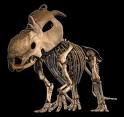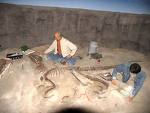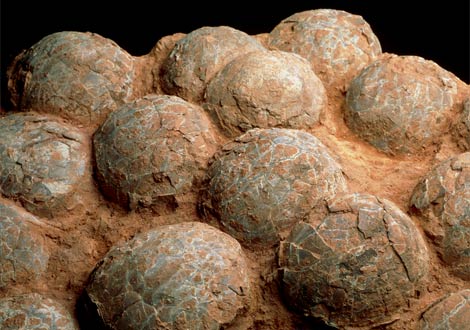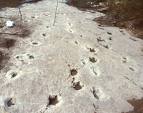Dinosaur Fossilized Remains
Homepage > Dinosaur Articles - Dinosaur Fossilized Remains
Fossils are the remains of once living organisms. Paleontologists focuses on reconstructing the lives of extinct animals based on the fossil evidence that is left behind. Dinosaur fossils are among the most studied fossils of all.
The most common finds in dinosaur fossils are individual bones, and sometimes more rarely complete skeletons. From this fossil finds scientists are able to draw conclusions that teaches us about the dinosaurs evolution, enable us to identify different species, and also we learn how they were related to each other and other animals that lived during their time.
 Complete
dinosaur skeletons have been found only on a few dinosaurs. Most of the
major groups of dinosaurs include at least one member for which a skeleton
is known. Skeletons draw a clearer picture, and help us to construct dinosaurs
that are known only from pregnant area remains, or even single bones.
Complete
dinosaur skeletons have been found only on a few dinosaurs. Most of the
major groups of dinosaurs include at least one member for which a skeleton
is known. Skeletons draw a clearer picture, and help us to construct dinosaurs
that are known only from pregnant area remains, or even single bones.
When reconstructing dinosaurs from fossilized remains paleontologist carefully note individual features of the bones of a friend dinosaurs and study had these features are distributed. There is a particular interest in features that are not seen in ancestors, these new features usually suggest evolutionary changes in the species. The more features we find that have similar distribution, the better we can group dinosaurs.
 Bones
and skeletons are the foundation and the starting point were rebuilding
the appearance of an extinct creature. Paleontologists draw clues from
these bones and identify in which ways they served the living animal.
Bones
and skeletons are the foundation and the starting point were rebuilding
the appearance of an extinct creature. Paleontologists draw clues from
these bones and identify in which ways they served the living animal.
For example dinosaurs that walked on all fours will have more robust hands than the same bones of a relative that walked with its hands-free.
When we look at claws we see that sharp claws are designed for slashing and holding, blunt claws are used for walking on. Meat eating dinosaurs require sharp teeth for ripping flesh, on the other hand plant eating dinosaurs need grinding teeth to pulp their food.
Fossilized bones also give important clues regarding the soft parts of the dinosaurs which may have not fossilized. When muscles attached to bones they leave scars, and these scars can reveal the way in which the animal moved a limb or how strong it was. The braincase gives us clues of what the living brain was like, even though brain material never fossilized.
Injury and these fees can also be diagnosed when starting the fossilized remains of dinosaurs. Some of the diseases that have been identified by looking at bones include cancers, arthritis, and gout. Injuries protected include bones that have been broken and gouges from fighting with members of their own species or with predators.
We learn many things from the arrangement of the skeleton worried was discovered. A complete skeleton may suggest a quick burial after death, where as a collection of scattered bones may suggest that the carcass was scavenged, or the bones were washed away from the rest of the skeleton in a stream or flood.
 Some
of the rarest of dinosaur fossils preserve soft tissue such as feathers,
skin, muscle, or very rarely internal organs. This is because fossilization
requires exceptional circumstances for the process to happen.
Some
of the rarest of dinosaur fossils preserve soft tissue such as feathers,
skin, muscle, or very rarely internal organs. This is because fossilization
requires exceptional circumstances for the process to happen.
Feathers are most famously known from some of the specimens of Archaeopteryx, which was discovered in 1860. More recently discoveries in China includes early birds and bird like dinosaurs with feathers and feather like structures still attached.
In these special cases the remains of the carcass were preserved in extremely fine grained sediments and where unaffected by scavengers. The occurrence of feathers associated with small theropod dinosaurs is crucial to our understanding of the origin of birds.
Skin, or impressions revealed to us that dinosaurs had a scaly covering, similar to that of modern crocodiles or to some lizards. Skin impressions are usually preserved after he dinosaur died and fell into a fine mind that harden soon after contact.
 Fossilized
dinosaur eggs and embryos reveal a wealth of information about the dinosaur
reproduction, development, and behavior. Large dinosaur nests that have
been found in the United States, Argentina, and Mongolia showed that some
dinosaurs nested in huge groups and that they return to their nesting
grounds year after year.
Fossilized
dinosaur eggs and embryos reveal a wealth of information about the dinosaur
reproduction, development, and behavior. Large dinosaur nests that have
been found in the United States, Argentina, and Mongolia showed that some
dinosaurs nested in huge groups and that they return to their nesting
grounds year after year.
Studies of dinosaur nests revealed that some of the young dinosaurs stayed in the nest for a certain time after hatching. Their parents must have attended to them and fed them during this time period. On the other hand other types of dinosaurs appeared not to have giving parental care to their offspring. They seem to have deserted their eggs as soon as they were laid, leaving their young defense for themselves.
 Footprints
and track ways have been found for most of the major dinosaur groups,
and they provide important clues to the movement and behavior patterns
of their makers.
Footprints
and track ways have been found for most of the major dinosaur groups,
and they provide important clues to the movement and behavior patterns
of their makers.
When we look at the spacing of these tracks we can calculate the size of the animal and the possible speed at which he was traveling.
Several dinosaur tracks moving in the same direction may indicate that these dinosaurs moved in groups. However, associating footprints and track ways with the dinosaurs that made them is an imprecise science.